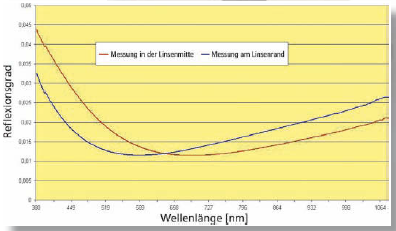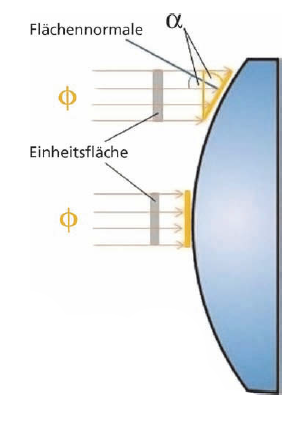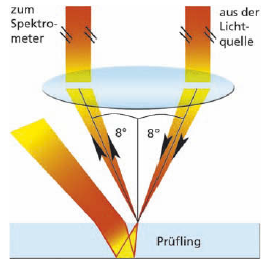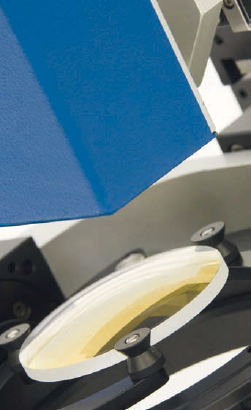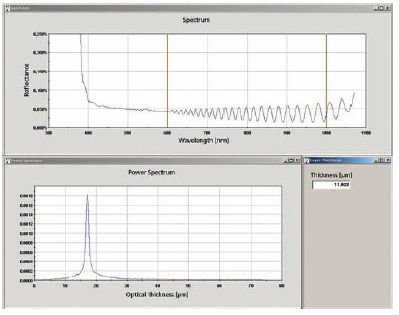Image 1: Spectral reflectance of a single layer of MgF2 on a commercially available plano-convex lens (diameter 50 mm, curvature radius ~50 mm) when measured at the lens center (red curve) and at the edge (blue curve). The spectrum from the lens edge is significantly blue-shifted.
2.Non-destructive Measurement
Many of the disadvantages of the classical destructive measurement method described above can be avoided by masking out the backside reflection through an innovative measurement head concept and replacing the scanning spectrophotometer with a diode array spectrometer. In such a device concept, broadband spectral light is guided to the measurement head via fiber optics and focused nearly perpendicularly, for example, at an angle of 8° to the incident slot, onto the lens surface (Image 3).
The light reflected from there under an angle of -8° to the incident slot according to the law of reflection is collected and guided via another fiber optic into a polychromator, where a diode array records the spectral intensity distribution in the exit slit plane. With focus and tilt sensors, the measurement head can be aligned at any point above the lens surface at the correct distance and angle, even outside the lens center2.
At the chosen angle of incidence of 8°, sufficient geometric separation of front and backside reflection is achieved. Only the frontside reflection is imaged onto the receiving optics. Moreover, the deviations from a measurement at 0° and the influence of the polarization direction of the incident light can still be neglected. An additional spatial filter helps in separating front and backside reflection, allowing even lenses with a thickness of only 2 mm to be measured well, without the need to roughen and blacken their backside (Image 4).
As a comparative measurement method, the achievable photometric measurement accuracy largely depends on the accuracy of the spectral reflectance of the used reference. It is recommended to choose a reference whose reflectance is within a few percentage points of the expected reflectance for the samples to be measured. Particularly suitable in this context are uncoated glass substrates of known materials. Its dispersion curve – and thus the spectral reflectance curve – can be calculated with very high accuracy using the Sellmeier coefficients tabulated in glass catalogs.
The measurement accuracy can be verified by referencing with an uncoated glass substrate of one material and then measuring an uncoated glass substrate of another material. A photometric accuracy of approximately ±0.5% of the spectral reflectance of the used reference is achieved. Therefore, if, for example, N-BK10 with R = 4% is chosen as a reference, an accuracy of R < ±0.02% is achieved.
3. Color Determination and Layer Thickness
Considering the spectrum ϕ(λ) = S(λ)·ρ(λ) captured by the spectrometer as the color stimulus function, where S(λ) represents the spectrum of the light source and ρ(λ) denotes the spectral reflectance, the normalized color value components x and y (the color locus), as well as the tristimulus values X, Y, and Z of the color stimulus of the coating in the CIE 1931 Standard Colorimetric System, can be calculated directly from this function, as shown in Image 5.
Determining the color locus during the measurement of antireflective coatings is indeed meaningful, as this allows for the selection of lenses from multiple measurements that possess a similar color locus. This is desirable, for example, in the assembly of binoculars or eyeglasses. With the presented measurement method, the thickness of a single layer can also be determined from the spectral reflectance curve, provided that the refractive index (or refractive index distribution) of the layer material is known. For layer thicknesses above approximately 1 μm, a Fourier transformation is used for this purpose, while for thinner layers, curve fitting is employed.
Furthermore, this option of determining layer thickness is also well suited for measuring the thickness of adhesive layers, provided that they are located between lens elements, each of which is at least 2 mm thick (Image 6). Since the diameter of the measuring spot is significantly smaller than 1 mm and the measurement method allows measurements at arbitrary points, it is even possible to investigate the homogeneity of the adhesive layer in this way.
4. Summary and Outlook
The presented innovative method enables very rapid, direct, and non-destructive measurement of the spectral reflectance at any point on curved, AR-coated lens surfaces through an intelligent measurement head concept.
The backside reflection of the sample is masked out. The ability to measure actual products rather than just specific test samples results in multiple additional benefits for quality control, development, and production. The measurement method achieves a similar high accuracy as conventional measurements with high-quality spectrophotometers without elaborate sample preparation, thus offering itself as an alternative or meaningful complement to the classical measurement method.
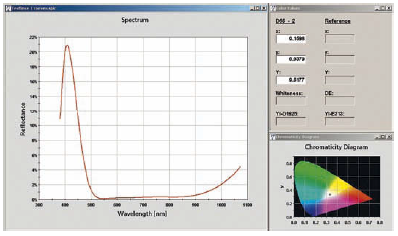
Image 5: Typical measurement result showing the determination of the normalized color value components x and y as well as the tristimulus value Y (brightness) for a 2° standard observer and standard illuminant D65.
References:
[1] M. Schulz-Grosser, Reale Transmission von Objektiven und optischen Systemen, Vortrag, 7. Arbeitstreffen des AK DUV/VUV-Optik, Dresden, 28. Sept. 2004
[2] H. Frey, G. Kienel (Hrsg.), Dünnschichttechnologie, VDI Verlag, Düsseldorf, 1987, S. 282
[3] J. Bliedtner, G. Gräfe, Optiktechnologie, Fachbuchverlag Leipzig, 2008, S. 49
[4] M. Richter, Einführung in die Farbmetrik, Walter de Gruyter, Berlin 1981, 2. Aufl ., S. 68 ff


